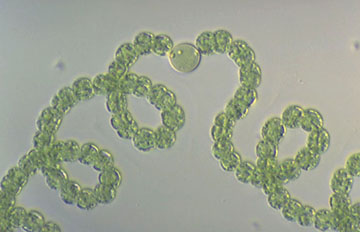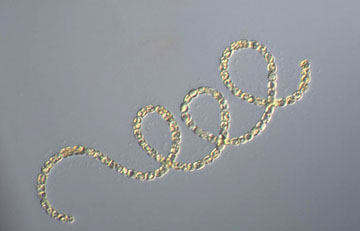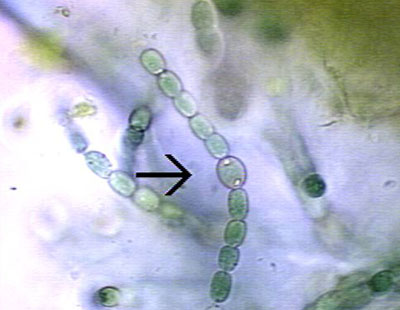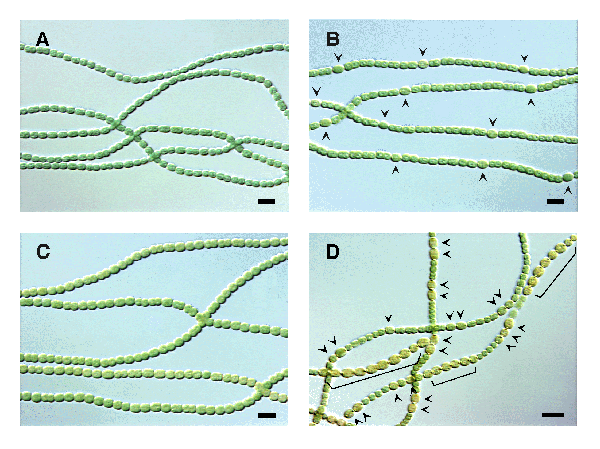Anabaena: Difference between revisions
No edit summary |
No edit summary |
||
| Line 1: | Line 1: | ||
<div align="center"></div><div align="center"> | |||
{| width="800" cellspacing="2" cellpadding="2" align="center" | |||
| width="155" height="452" bgcolor="#ffffff" valign="top" | | |||
<div align="left"></div><div align="center"><div align="left"><div align="center"> | |||
</div><div align="center"> | |||
| height="69" bgcolor="#FFDF95" | | |||
'''NCBI:<br />[http://www.ncbi.nlm.nih.gov/Taxonomy/Browser/wwwtax.cgi?id=1163 Taxonomy]<br />[http://www.ncbi.nlm.nih.gov/entrez/query.fcgi?db=genomeprj&cmd=Retrieve&dopt=Overview&list_uids=10642 Genome ]''' | '''NCBI:<br />[http://www.ncbi.nlm.nih.gov/Taxonomy/Browser/wwwtax.cgi?id=1163 Taxonomy]<br />[http://www.ncbi.nlm.nih.gov/entrez/query.fcgi?db=genomeprj&cmd=Retrieve&dopt=Overview&list_uids=10642 Genome ]''' | ||
|}</div></div></div> | |}</div></div></div> | ||
[[Image:0008L.jpg]]<br />''Anabaena flos-aquae f. flos-aquae''. From the [http://www.nies.go.jp/biology/mcc/strainlist_a.htm#Anabaena Microbial Culture Collection] | [[Image:0008L.jpg]]<br />''Anabaena flos-aquae f. flos-aquae''. From the [http://www.nies.go.jp/biology/mcc/strainlist_a.htm#Anabaena Microbial Culture Collection] | ||
''[[Image:1002L.jpg]]<br /> Anabaena oumiana. ''From the [http://www.nies.go.jp/biology/mcc/strainlist_a.htm#Anabaena Microbial Culture Collection] | ''[[Image:1002L.jpg]]<br /> Anabaena oumiana. ''From the [http://www.nies.go.jp/biology/mcc/strainlist_a.htm#Anabaena Microbial Culture Collection] | ||
|- | |||
| Classification | |||
|} | |} | ||
{| width="800" cellspacing="2" cellpadding="2" align="center" | {| width="800" cellspacing="2" cellpadding="2" align="center" | ||
| height="2114" bgcolor="#ffffff" valign="top" | | | height="2114" bgcolor="#ffffff" valign="top" | | ||
== | ==Classification== | ||
< | <br /> | ||
==<font size="+1">''''''</font>Cell Structure and Metabolism== | ===Higher order taxa:=== | ||
'''''' Bacteria; Cyanobacteria; Nostocales; Nostocaceae; Anabaena <br /> | |||
===Species:=== | |||
''Anabaena sp. PCC 7120, Anabaena flos-aque'', ''Anabaena aequalis ''<br /><font size="+1"> </font> | |||
==Description and Significance== | |||
<br />''Anabaena'' provides a model for the study of gene differentiation in the formation of heterocysts. The recent sequencing of the genome of ''Anabaena sp''. strain PCC 7120 is yet another step towards understanding this process. <br /> | |||
==Genome Structure== | |||
<br /> The genome of the circular chromosome of the PCC 7120 strain of ''Anabaena'' has been sequenced. It contains 1 chromosome with 6,413,771 base pairs with 5,368 predicted protein-coding regions, and six plasmids ranging from 408,101 base pairs to 5,584 base pairs. The sequencing of the anabaena genome will aid researchers in studying the genetics and physiology of cellular differentiation, (as exhibited in the heterocycsts of ''Anabaena'') pattern formation, and nitrogen fixation. [http://www.kazusa.or.jp/cyano/Anabaena/index.html Distribution maps for chromosome and six plasmids, courtesy of Cyanobase.] The genome of <font size="+0">''Anabaena variabilis'' ATCC 29413</font><font size="3"> has also been completed. Unlike most other strains of ''Anabaena'', <font size="+1">''Anabaena sp. strain ATCC 29413 '' </font></font> <font size="3"> differenciates between their hetrocyst and akinetes forms. This provides a model for the study of gene differentiation in the formation of heterocysts and akinetes. Akinetes are the resting forms of a organism.</font><font size="3"> </font> | |||
==Cell Structure and Metabolism== | |||
{| width="100%" | {| width="100%" | ||
| Line 23: | Line 47: | ||
|} | |} | ||
== | ==Ecology== | ||
{| width="100%" | <br /> It is commonly accepted that cyanobacteria played a key role in the manufacturing of oxygen during the Precambrian period of earth's history. They perform oxygenic photosynthesis, very similar to that of eukaryotic plants and algae, by utilizing water as a reductant source, consequently producing molecular oxygen. Heterocysts, mentioned above, are terminally differentiated cells that specialize in nitrogen fixation. It is believed that the capacity for developing heterocysts first developed when the concentration of oxygen in the atmosphere (largely produced by cyanobacteria) reached levels high enough to cause the inactivation of the nitrogen-fixing enzyme nitrogenase.<font size="+1">'''<br />'''</font><br /> The mechanism of cellular differentiation, or the gene that initiates heterocyst formation has been the focus of much research. To date researchers have found two genes that control both the initiation of heterocyst formation and the frequency of differentiated cells. The product of the ''hetR'' gene is required for heterocyst differentiation and is only transcribed in differentiating cells. The ''patS'' gene regulates the frequency at which cells develop into heterocysts, or essentially inhibits heterocyst formation. The two genes work very differently as evidenced when studying cells carrying mutant genotypes. Cells with mutant ''hetR'' genes do not differentiate at all, where as cells with mutant ''patS'' genes differentiate too often. Conversely, cells that carry extra copies of the ''hetR'' gene differentiate additional heterocysts, and cells with extra copies of the ''patS'' gene do not differentiate at all. {| width="100%" | ||
| | | | ||
<div align="center">[[Image:anabaenamutants.gif]]</div> | <div align="center">[[Image:anabaenamutants.gif]]</div> | ||
| Line 33: | Line 57: | ||
|} | |} | ||
<br /> | |||
==References== | |||
Updated May 31, 2006 | |||
[http://www.kazusa.or.jp/cyano/Anabaena/index.html Cyanobase: Anabaena sp. PCC 7120] | [http://www.kazusa.or.jp/cyano/Anabaena/index.html Cyanobase: Anabaena sp. PCC 7120] | ||
| Line 39: | Line 67: | ||
[http://www.expasy.org/spotlight/back_issues/2002/06/heterocyst_or_n.shtml ExPaSy Molecular Biology Server: Heterocyst or not Heterocyst?] | [http://www.expasy.org/spotlight/back_issues/2002/06/heterocyst_or_n.shtml ExPaSy Molecular Biology Server: Heterocyst or not Heterocyst?] | ||
[http://www.pubmedcentral.gov/articlerender.fcgi?artid=545720 Guocun Huang, Qing Fan, Sigal Lechno-Yossef, Elizabeth Wojciuch, C. Peter Wolk, Takakazu Kaneko, and Satoshi Tabata. Clustered Genes Required for the Synthesis of Heterocyst Envelope Polysaccharide in ''Anabaena'' sp. Strain PCC 7120. J Bacteriol. 2005 February; 187(3): | [http://www.pubmedcentral.gov/articlerender.fcgi?artid=545720 Guocun Huang, Qing Fan, Sigal Lechno-Yossef, Elizabeth Wojciuch, C. Peter Wolk, Takakazu Kaneko, and Satoshi Tabata. Clustered Genes Required for the Synthesis of Heterocyst Envelope Polysaccharide in ''Anabaena'' sp. Strain PCC 7120. J Bacteriol. 2005 February; 187(3): 1114-1123.] | ||
[http://www.aslo.org/lo/toc/vol_17/issue_5/0693.pdf Horne, A. J., J. E. Dillard, D. K. Fujita, C. R. Goldman. Nitrogen Fixation in Clear Lake California. II. Synoptic Studies on the Anabaena Bloom. American Society of Limnology and Oceanography. 1972, Vol. 17, Issue 5, Pg 702 (10 of 11). ] | [http://www.aslo.org/lo/toc/vol_17/issue_5/0693.pdf Horne, A. J., J. E. Dillard, D. K. Fujita, C. R. Goldman. Nitrogen Fixation in Clear Lake California. II. Synoptic Studies on the Anabaena Bloom. American Society of Limnology and Oceanography. 1972, Vol. 17, Issue 5, Pg 702 (10 of 11).] | ||
[http://biology.kenyon.edu/courses/biol114/Chap12/Chapter_12.html Kenyon College: Heterocyst formation in Anabaena and other cyanobacteria] | [http://biology.kenyon.edu/courses/biol114/Chap12/Chapter_12.html Kenyon College: Heterocyst formation in Anabaena and other cyanobacteria] | ||
| Line 47: | Line 75: | ||
[http://mmbr.asm.org/cgi/content/full/66/1/1#Nitrogenases Microbiology and Molecular Biology Reviews: Nitrogenase] | [http://mmbr.asm.org/cgi/content/full/66/1/1#Nitrogenases Microbiology and Molecular Biology Reviews: Nitrogenase] | ||
[http://dna-res.kazusa.or.jp/8/6/03/PDF/8_271.pdf Masayuki, Ohmori et al. 2001. Characterization of genes encoding multi-domain proteins in the genome of the filamentous nitrogen-fixing cyanobacterium Anabaena sp. strain PCC 7120. DNA Research, 8: 271-284. ] | [http://dna-res.kazusa.or.jp/8/6/03/PDF/8_271.pdf Masayuki, Ohmori et al. 2001. Characterization of genes encoding multi-domain proteins in the genome of the filamentous nitrogen-fixing cyanobacterium Anabaena sp. strain PCC 7120. DNA Research, 8: 271-284.] | ||
[http://www.dna-res.kazusa.or.jp/8/5/02/PDF/8_205.pdf Takakazu, Kaneko et al. 2001. Complete genomic sequence ot the filamentous nitrogen-fixing cyanobacterium Anabaena sp. strain PCC 7120. DNA Research, 8: 205-213. ] | [http://www.dna-res.kazusa.or.jp/8/5/02/PDF/8_205.pdf Takakazu, Kaneko et al. 2001. Complete genomic sequence ot the filamentous nitrogen-fixing cyanobacterium Anabaena sp. strain PCC 7120. DNA Research, 8: 205-213.] | ||
[http://www2.kenyon.edu/local2/depts/biology/biol14/articles/heterocyst/heterocyst.htm University of Chicago: How Cyanobacteria Count to 10] | [http://www2.kenyon.edu/local2/depts/biology/biol14/articles/heterocyst/heterocyst.htm University of Chicago: How Cyanobacteria Count to 10] | ||
<div align="left"></div> | <div align="left"></div> | ||
<br /></div> | <br /></div> | ||
<br /><br /><br /><br /><br /> | <br /><br /><br /><br /><br /> | ||
Revision as of 18:38, 31 May 2006

Anabaena flos-aquae f. flos-aquae. From the Microbial Culture Collection

Anabaena oumiana. From the Microbial Culture Collection
|-
| Classification
|}
Classification
Higher order taxa:' Bacteria; Cyanobacteria; Nostocales; Nostocaceae; Anabaena Species:Anabaena sp. PCC 7120, Anabaena flos-aque, Anabaena aequalis Description and Significance
Genome Structure
Cell Structure and Metabolism
Ecology
|
|||
|
Figure A shows normal Anabaena grown in a complete medium. Figure B shows normal Anabaena growing in a medium lacking nitrogen, arrows indicate heterocysts. Figure C shows an overexpression of the patS gene, which inhibits heterocyst formation even in nitrogen-depleted conditions. Figure D shows the deletion of the patS gene resulting in the differentiation of additional heterocysts, arrows and brackets indicate heterocysts.
From Texas A&M University |
References
Updated May 31, 2006
Cyanobase: Anabaena sp. PCC 7120
ExPaSy Molecular Biology Server: Heterocyst or not Heterocyst?
Kenyon College: Heterocyst formation in Anabaena and other cyanobacteria
Microbiology and Molecular Biology Reviews: Nitrogenase
University of Chicago: How Cyanobacteria Count to 10


